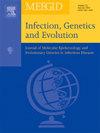The σNS protein of NDRV antagonizes TRIM59-mediated antiviral innate immune response of Cherry Valley duck
IF 2.6
4区 医学
Q3 INFECTIOUS DISEASES
引用次数: 0
Abstract
In recent years, outbreak of the novel duck reovirus (NDRV) disease has occurred frequently in duck populations. Due to its rapid spreading, absence of effective control methods, and high treatment costs, the NDRV disease has caused huge losses to waterfowl breeding in China. As reported, four non-structural (NS) proteins are encoded by the NDRV genome, among which the σNS protein is an RNA-binding protein that can improve the stability of bound RNA by forming oligomers (Adams and Cory, 1998). Nevertheless, the mechanism by which it facilitates reovirus replication remains ambiguous. According to previous studies, the NS protein 11 of the porcine reproductive and respiratory syndrome virus (PRRSV) can interact with tripartite motif-containing 59 (TRIM59) to regulate viral infection. However, the specific role of TRIM59 in NDRV infection remains unclear. This study focused on full-length amplification of duTRIM59, the mRNA distribution of duTRIM59 in Cherry Valley duck and successive biological examinations. The homology with Anas platyrhynchos TRIM59 was 98.6 %. The mRNA distribution level of duTRIM59 showed that duTRIM59 was widely expressed in bursae and thymus of the immune organs. Nevertheless, TRIM59 comprises three domains, including the transmembrane (TM), B-box (B), and RING-finger (R) domains. It also has the activity of ubiquitin-protein ligase (E3). It has been demonstrated that NDRV replication is inhibited by TRIM59 overexpression in duck embryonic fibroblasts (DEF) cells, particularly when the R domain is intact, suggesting that the R domain plays a key role in the spreading of the NDRV virus. In contrast, NDRV infection in DEF cells increased when TRIM59 was depleted by using small interfering RNA. Moreover, the σNS protein can be co-localized with duTRIM59 and stimulate NDRV replication in DEF cells in cases of NDRV infection. This study clarifies the correlation of NDRV infection and TRIM59-mediated antiviral innate immunity, and provides a sound theoretical basis for further understanding this disease.
求助全文
约1分钟内获得全文
求助全文
来源期刊

Infection Genetics and Evolution
医学-传染病学
CiteScore
8.40
自引率
0.00%
发文量
215
审稿时长
82 days
期刊介绍:
(aka Journal of Molecular Epidemiology and Evolutionary Genetics of Infectious Diseases -- MEEGID)
Infectious diseases constitute one of the main challenges to medical science in the coming century. The impressive development of molecular megatechnologies and of bioinformatics have greatly increased our knowledge of the evolution, transmission and pathogenicity of infectious diseases. Research has shown that host susceptibility to many infectious diseases has a genetic basis. Furthermore, much is now known on the molecular epidemiology, evolution and virulence of pathogenic agents, as well as their resistance to drugs, vaccines, and antibiotics. Equally, research on the genetics of disease vectors has greatly improved our understanding of their systematics, has increased our capacity to identify target populations for control or intervention, and has provided detailed information on the mechanisms of insecticide resistance.
However, the genetics and evolutionary biology of hosts, pathogens and vectors have tended to develop as three separate fields of research. This artificial compartmentalisation is of concern due to our growing appreciation of the strong co-evolutionary interactions among hosts, pathogens and vectors.
Infection, Genetics and Evolution and its companion congress [MEEGID](http://www.meegidconference.com/) (for Molecular Epidemiology and Evolutionary Genetics of Infectious Diseases) are the main forum acting for the cross-fertilization between evolutionary science and biomedical research on infectious diseases.
Infection, Genetics and Evolution is the only journal that welcomes articles dealing with the genetics and evolutionary biology of hosts, pathogens and vectors, and coevolution processes among them in relation to infection and disease manifestation. All infectious models enter the scope of the journal, including pathogens of humans, animals and plants, either parasites, fungi, bacteria, viruses or prions. The journal welcomes articles dealing with genetics, population genetics, genomics, postgenomics, gene expression, evolutionary biology, population dynamics, mathematical modeling and bioinformatics. We also provide many author benefits, such as free PDFs, a liberal copyright policy, special discounts on Elsevier publications and much more. Please click here for more information on our author services .
 求助内容:
求助内容: 应助结果提醒方式:
应助结果提醒方式:


